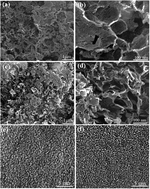当前位置:
X-MOL 学术
›
Sustain. Energy Fuels
›
论文详情
Our official English website, www.x-mol.net, welcomes your feedback! (Note: you will need to create a separate account there.)
Enhanced storage capability by biomass-derived porous carbon for lithium-ion and sodium-ion battery anodes†
Sustainable Energy & Fuels ( IF 5.6 ) Pub Date : 2018-09-02 00:00:00 , DOI: 10.1039/c8se00353j Jian Hao 1, 2, 3, 4, 5 , Yanxia Wang 1, 2, 3, 4, 5 , Caixia Chi 5, 6, 7, 8 , Jing Wang 5, 9, 10, 11 , Qingjie Guo 1, 2, 3, 4, 5 , Yu Yang 5, 6, 7, 8 , Yao Li 5, 7, 8, 12 , Xiaoxu Liu 5, 6, 7, 8 , Jiupeng Zhao 5, 6, 7, 8
Sustainable Energy & Fuels ( IF 5.6 ) Pub Date : 2018-09-02 00:00:00 , DOI: 10.1039/c8se00353j Jian Hao 1, 2, 3, 4, 5 , Yanxia Wang 1, 2, 3, 4, 5 , Caixia Chi 5, 6, 7, 8 , Jing Wang 5, 9, 10, 11 , Qingjie Guo 1, 2, 3, 4, 5 , Yu Yang 5, 6, 7, 8 , Yao Li 5, 7, 8, 12 , Xiaoxu Liu 5, 6, 7, 8 , Jiupeng Zhao 5, 6, 7, 8
Affiliation

|
Efficient electrodes with impressive storage capability and fast ion transfer rate are urgently needed to meet the demand for higher energy/power densities and longer life cycles and large rate powering devices. Through a simple freeze-drying and annealing process, nitrogen-containing porous carbon materials with a hierarchical porous structure and enlarged lattice spacing between graphene layers are synthesized. Benefiting from an improvement in the electrochemical activity, porosity, conductive network and mechanical stability, the porous carbon used as anodes for lithium-ion batteries (LIBs) and sodium-ion batteries (SIBs) exhibits an excellent storage capability, rate performance, and cyclability. Apple carbon exhibits a high capacity of 1050 mA h g−1, and celery carbon shows the reversible capacities of 990 mA h g−1 at 0.1 A g−1 after the 200th cycle as LIBs anodes. For SIBs, a high capacity of 438 mA h g−1 is obtained after 200 cycles for apple carbon and 451 mA h g−1 for celery carbon. It is noteworthy that celery carbon shows a capacity retention of 94% between the 50th to 200th cycling. Further analysis on the structure characterization and charging curves reveal that celery carbon has a high N content, dilated intergraphene spacing, and an intrinsically hierarchical porous structure, which are capable of reversibly accumulating sodium ions through surface adsorption and sodium intercalation. Also, the electrochemical impedance spectroscopy (EIS) reveals that celery carbon has a low charge-transfer resistance, the enhanced cyclability and rate performance might be attributed to convenient ion diffusion in the electrode.
中文翻译:

源自生物质的多孔碳增强了锂离子和钠离子电池阳极的储存能力†
迫切需要具有令人印象深刻的存储能力和快速的离子转移速率的高效电极,以满足对更高的能量/功率密度,更长的使用寿命和大功率设备供电的需求。通过简单的冷冻干燥和退火工艺,合成了具有分层多孔结构和石墨烯层之间晶格间距增大的含氮多孔碳材料。得益于电化学活性,孔隙率,导电网络和机械稳定性的改进,用作锂离子电池(LIB)和钠离子电池(SIB)阳极的多孔碳表现出出色的储存能力,倍率性能和可循环性。苹果碳表现出1050 mA hg -1的高容量,并且在第200次循环后,作为LIB阳极,芹菜碳在0.1 A g -1下显示990 mA hg -1的可逆容量。对于SIB,苹果碳和451 mA hg -1循环200次后可获得438 mA hg -1的高容量芹菜碳。值得注意的是,在第50至200次循环之间,芹菜碳显示出94%的容量保持率。对结构特征和带电曲线的进一步分析表明,芹菜碳具有高的N含量,膨胀的石墨烯间距和固有的层级多孔结构,能够通过表面吸附和钠嵌入可逆地积累钠离子。此外,电化学阻抗谱(EIS)揭示了芹菜碳具有低电荷转移电阻,增强的循环能力和速率性能可能归因于电极中方便的离子扩散。
更新日期:2018-09-02
中文翻译:

源自生物质的多孔碳增强了锂离子和钠离子电池阳极的储存能力†
迫切需要具有令人印象深刻的存储能力和快速的离子转移速率的高效电极,以满足对更高的能量/功率密度,更长的使用寿命和大功率设备供电的需求。通过简单的冷冻干燥和退火工艺,合成了具有分层多孔结构和石墨烯层之间晶格间距增大的含氮多孔碳材料。得益于电化学活性,孔隙率,导电网络和机械稳定性的改进,用作锂离子电池(LIB)和钠离子电池(SIB)阳极的多孔碳表现出出色的储存能力,倍率性能和可循环性。苹果碳表现出1050 mA hg -1的高容量,并且在第200次循环后,作为LIB阳极,芹菜碳在0.1 A g -1下显示990 mA hg -1的可逆容量。对于SIB,苹果碳和451 mA hg -1循环200次后可获得438 mA hg -1的高容量芹菜碳。值得注意的是,在第50至200次循环之间,芹菜碳显示出94%的容量保持率。对结构特征和带电曲线的进一步分析表明,芹菜碳具有高的N含量,膨胀的石墨烯间距和固有的层级多孔结构,能够通过表面吸附和钠嵌入可逆地积累钠离子。此外,电化学阻抗谱(EIS)揭示了芹菜碳具有低电荷转移电阻,增强的循环能力和速率性能可能归因于电极中方便的离子扩散。



























 京公网安备 11010802027423号
京公网安备 11010802027423号